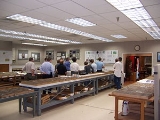
Core Research Center
Encyclopedia
The Core Research Center is a facility run by the United States Geological Survey
, located in "F" bay in building 810 on the Denver Federal Center
campus. It is maintained by the USGS to preserve valuable rock cores, well cuttings and various other geologic samples for use by scientists and educators from government, industry and academia. The CRC is open to the general public for core viewings or tours of the facility by appointment only. The CRC houses the largest collection of rock cores and well cuttings in the nation.
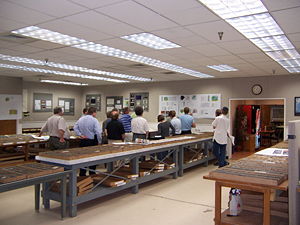
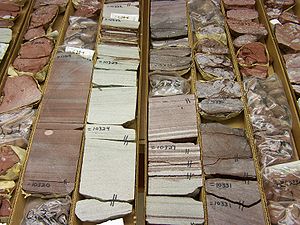

, USGS Yellowstone Drilling Program, Manson Impact Structure
, plus more.
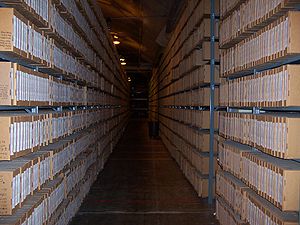 In addition to the core and cuttings collections, the CRC also houses a collection of over 18,000 thin section
In addition to the core and cuttings collections, the CRC also houses a collection of over 18,000 thin section
s of core and cuttings that are viewed through microscopes by researchers. Photographs of archived cores are also available to researchers. Files are maintained for many wells that contain chemical and physical analyses, core descriptions, stratigraphic charts, and other analyses performed by daily users.
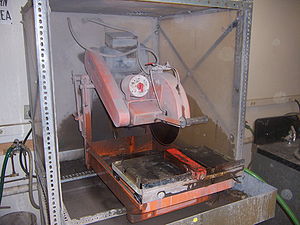 The Core Research Center has a large collection of drilled materials from the Green River Formation
The Core Research Center has a large collection of drilled materials from the Green River Formation
of Western Colorado
, Eastern Utah
, and Southwestern Wyoming
. The collection contains cores from over 400 holes, along with associated thin sections and analytical data.
.
United States Geological Survey
The United States Geological Survey is a scientific agency of the United States government. The scientists of the USGS study the landscape of the United States, its natural resources, and the natural hazards that threaten it. The organization has four major science disciplines, concerning biology,...
, located in "F" bay in building 810 on the Denver Federal Center
Denver Federal Center
Denver Federal Center is located in Lakewood, Colorado and is the home to about 6,200 employees for many Federal government of the United States agencies. The Denver Federal Center encompasses an area of about and has 90 buildings comprising over of office, warehouse, lab and special use space...
campus. It is maintained by the USGS to preserve valuable rock cores, well cuttings and various other geologic samples for use by scientists and educators from government, industry and academia. The CRC is open to the general public for core viewings or tours of the facility by appointment only. The CRC houses the largest collection of rock cores and well cuttings in the nation.

History
Established in 1974 by the USGS, in cooperation with the Rocky Mountain Association of Geologists, the CRC was designed as a permanent free-access core repository. Its goal was to rescue rock cores threatened with disposal or destruction, which continues today with the recent rescue of the Denver Basin drill core from Castle Pines North, Colorado. During the 1990s the CRC staff provided onsite core processing services to active scientific drilling programs.
Archived Core
Archived Cores have been slabbed, which means that it has been cut lengthwise, with a rock saw, which exposes a fresh flat surface to enhance the core viewing process. This also enables the cores to boxed and stored like books on a shelf, which allows for quick access to specific depth intervals.
Unprocessed Core
The CRC unprocessed core collection contains 1.1 million feet of drilled core, from 31 states. This general collection contains materials from petroleum exploration and energy development holes. Unprocessed cores are in their original boxes and are stored on pallets in the CRC warehouse.Cuttings
The CRC curates a large collection of well cuttings (rock chips) brought to the surface during drilling operations. This unique collection of cuttings represents 235 million feet of drilling. The USGS estimates that the replacement cost for this collection is around 10 billion dollars.Special Core Collections
Aside from the general petroleum core collection, there are various sub-collections, including Eniwetok Atoll, Cajon PassCajon Pass
Cajon Pass is a moderate-elevation mountain pass between the San Bernardino Mountains and the San Gabriel Mountains in Southern California in the United States. It was created by the movements of the San Andreas Fault...
, USGS Yellowstone Drilling Program, Manson Impact Structure
Manson crater
The Manson impact crater is near the site of Manson, Iowa where an asteroid or comet nucleus struck the Earth during the Cretaceous Period, 74 Ma...
, plus more.
Thin sections, photos, analysis

Thin section
In optical mineralogy and petrography, a thin section is a laboratory preparation of a rock, mineral, soil, pottery, bones, or even metal sample for use with a polarizing petrographic microscope, electron microscope and electron microprobe. A thin sliver of rock is cut from the sample with a...
s of core and cuttings that are viewed through microscopes by researchers. Photographs of archived cores are also available to researchers. Files are maintained for many wells that contain chemical and physical analyses, core descriptions, stratigraphic charts, and other analyses performed by daily users.
Oil Shale Collection

Green River Formation
The Green River Formation is an Eocene geologic formation that records the sedimentation in a group of intermountain lakes. The sediments are deposited in very fine layers, a dark layer during the growing season and a light-hue inorganic layer in winter. Each pair of layers is called a varve and...
of Western Colorado
Colorado
Colorado is a U.S. state that encompasses much of the Rocky Mountains as well as the northeastern portion of the Colorado Plateau and the western edge of the Great Plains...
, Eastern Utah
Utah
Utah is a state in the Western United States. It was the 45th state to join the Union, on January 4, 1896. Approximately 80% of Utah's 2,763,885 people live along the Wasatch Front, centering on Salt Lake City. This leaves vast expanses of the state nearly uninhabited, making the population the...
, and Southwestern Wyoming
Wyoming
Wyoming is a state in the mountain region of the Western United States. The western two thirds of the state is covered mostly with the mountain ranges and rangelands in the foothills of the Eastern Rocky Mountains, while the eastern third of the state is high elevation prairie known as the High...
. The collection contains cores from over 400 holes, along with associated thin sections and analytical data.
Sampling
The CRC does allow scientists to remove samples of material stored at the facility. There are special requirements and procedures in place to protect the material from oversampling. Contact the CRC for current procedures.National Ice Core Laboratory
The CRC shares a common facility with the National Ice Core LaboratoryNational Ice Core Laboratory
The National Ice Core Laboratory located at the Denver Federal Center is the primary repository for ice cores collected by the United States. The facility is managed by the United States Geological Survey , and jointly funded by the USGS, National Science Foundation, and the University of New...
.

